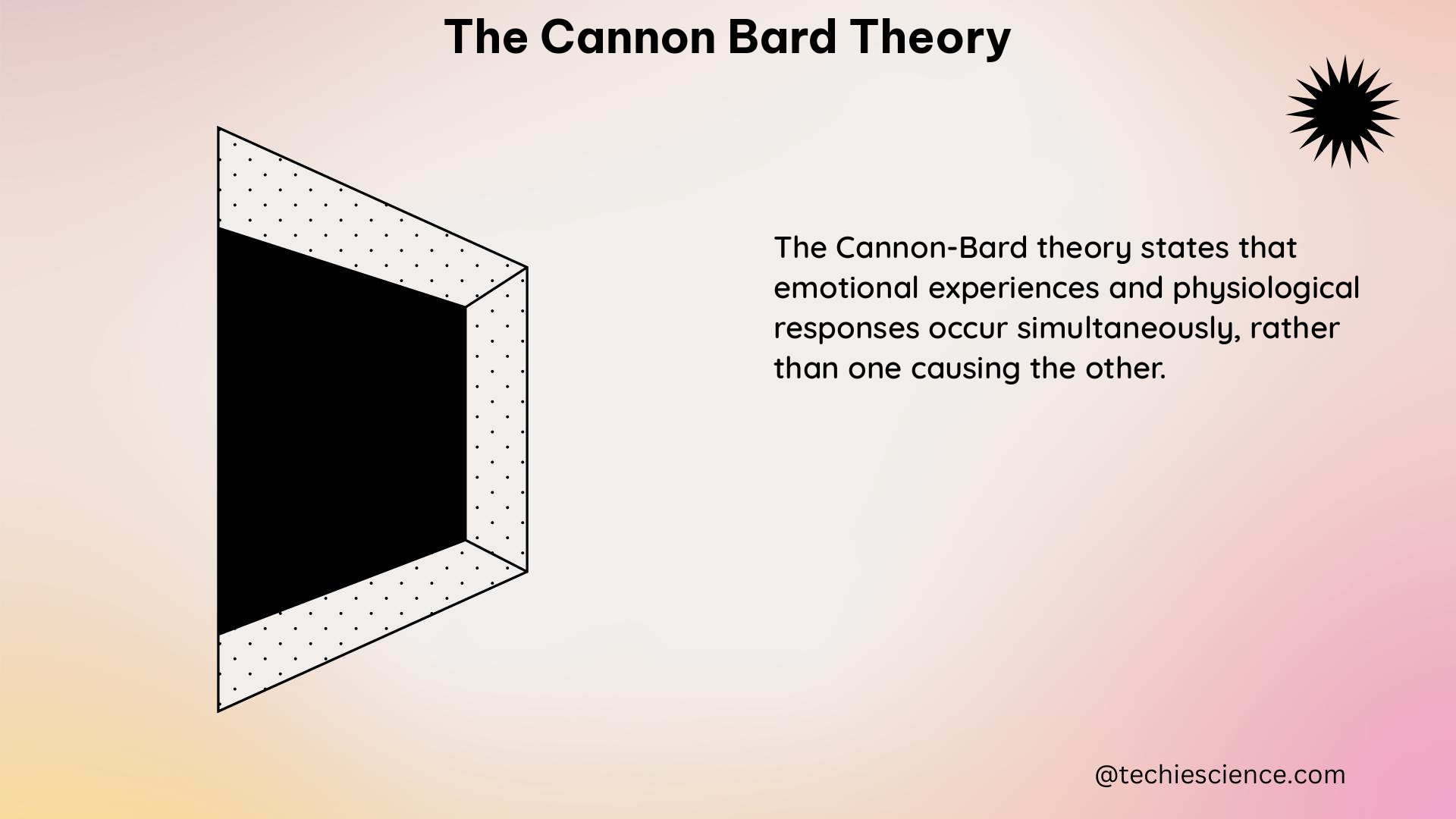The Cannon-Bard theory, also known as the Thalamic theory of emotion, is a model that emphasizes the role of the thalamic region as a coordinating center for emotional reactions. Developed in 1972 by Walter Cannon and Philip Bard, the theory posits that the dorsal thalamus is responsible for emotional feeling, while the lower part of the thalamus, known as the hypothalamus, is responsible for physiological expression.
The Cannon-Bard Theory: Key Principles
The Cannon-Bard theory states that emotional and physiological reactions occur simultaneously yet independently. When a potential stressful event occurs, the thalamus transmits a signal to the amygdala, which plays an important role in emotional processing and translating possible danger to the hypothalamus. The thalamus also sends signals to the cerebral cortex, which triggers the autonomic nervous system and skeletal muscles, resulting in physical reactions such as sweating, shaking, or muscle tension.
The Thalamic Region: The Coordinating Center
The Cannon-Bard theory emphasizes the crucial role of the thalamic region in emotional reactions. The thalamus is divided into two main parts:
- Dorsal Thalamus: Responsible for emotional feeling and subjective experience of emotion.
- Hypothalamus: Responsible for the physiological expression of emotion, such as changes in heart rate, blood pressure, and muscle tension.
According to the theory, the thalamus acts as a coordinating center, receiving and transmitting signals to various parts of the brain to elicit both the emotional and physiological responses.
Experimental Evidence Supporting the Cannon-Bard Theory
The Cannon-Bard theory is supported by experimental observations on animal physiology. For example, Cannon found that the removal of the cerebrum anterior to the thalamus did not influence the expression of rage-like emotional responses, while removal of the thalamus blocked such reactions. This evidence supports the key role of the thalamus in emotional reactions.
Cannon’s Experiments on Decorticated Cats
Cannon conducted experiments on decorticated cats, which involved the removal of the cerebral cortex. He observed that these cats still exhibited “sham rage” responses, such as hissing, arching their backs, and extending their claws, even after the removal of the cerebral cortex. This finding suggested that the emotional response was not dependent on the cerebral cortex, but rather on the thalamic region.
Bard’s Observations on Decorticated Cats
Philip Bard, Cannon’s collaborator, later observed that decorticated cats could also exhibit pleasure responses, such as purring and kneading, in addition to the “sham rage” responses. This observation further supported the Cannon-Bard theory’s emphasis on the thalamus as the coordinating center for both emotional feeling and physiological expression.
Criticisms and Limitations of the Cannon-Bard Theory

Despite the theory’s contributions to the understanding of emotions, it has also faced criticism from scholars. Some of the main criticisms and limitations of the Cannon-Bard theory include:
Overgeneralization of the Theory
Scholars have criticized Cannon for overextending his theory beyond the evidence provided by the Cannon-Bard experiments. Although Cannon studied the decorticated cat’s “sham rage” exclusively, he went on to extend his model of emotions to joy, grief, and disgust before Philip Baard himself observed pleasure in decorticated cats.
Contradictions Between Theory and Evidence
Some researchers have pointed out contradictions between the Cannon-Bard theory and empirical evidence. For example, the theory suggests that emotional and physiological reactions occur simultaneously, but some studies have found that physiological changes can precede the subjective experience of emotion.
Lack of Consideration for Cognitive Factors
The Cannon-Bard theory has been criticized for its lack of consideration for cognitive factors in the emotional process. The theory focuses primarily on the physiological and subcortical aspects of emotion, while neglecting the role of higher-order cognitive processes, such as appraisal and interpretation, in shaping emotional experiences.
Oversimplification of the Emotional Process
The Cannon-Bard theory has been criticized for oversimplifying the complex and multifaceted nature of emotional processes. Emotions involve a wide range of neural, physiological, and cognitive mechanisms that interact in intricate ways, and the Cannon-Bard theory may not adequately capture this complexity.
Conclusion
The Cannon-Bard theory is a significant contribution to the understanding of emotions, emphasizing the crucial role of the thalamic region as a coordinating center for emotional reactions. The theory’s experimental support and its emphasis on the simultaneous yet independent nature of emotional and physiological responses have been influential in the field of emotion research.
However, the theory has also faced criticism for its overgeneralization, contradictions with empirical evidence, and lack of consideration for cognitive factors in the emotional process. As our understanding of the neural and cognitive mechanisms underlying emotions continues to evolve, the Cannon-Bard theory remains an important historical perspective, but may need to be integrated with more comprehensive models of emotion to fully capture the complexity of this fundamental aspect of human experience.
References:
- Cannon, W. B. (1927). The James-Lange theory of emotions: A critical examination and an alternative theory. The American Journal of Psychology, 39(1/4), 106-124.
- Bard, P. (1928). A diencephalic mechanism for the expression of rage with special reference to the sympathetic nervous system. American Journal of Physiology-Legacy Content, 84(3), 490-515.
- Schachter, S., & Singer, J. E. (1962). Cognitive, social, and physiological determinants of emotional state. Psychological Review, 69(5), 379-399.
- Lazarus, R. S. (1991). Emotion and adaptation. Oxford University Press.
- LeDoux, J. E. (1996). The emotional brain: The mysterious underpinnings of emotional life. Simon & Schuster.
- Damasio, A. R. (1999). The feeling of what happens: Body and emotion in the making of consciousness. Harcourt Brace.

The lambdageeks.com Core SME Team is a group of experienced subject matter experts from diverse scientific and technical fields including Physics, Chemistry, Technology,Electronics & Electrical Engineering, Automotive, Mechanical Engineering. Our team collaborates to create high-quality, well-researched articles on a wide range of science and technology topics for the lambdageeks.com website.
All Our Senior SME are having more than 7 Years of experience in the respective fields . They are either Working Industry Professionals or assocaited With different Universities. Refer Our Authors Page to get to know About our Core SMEs.